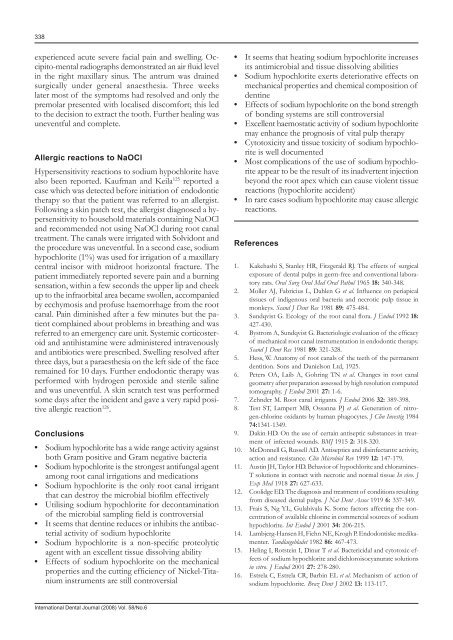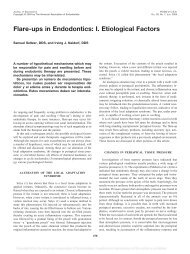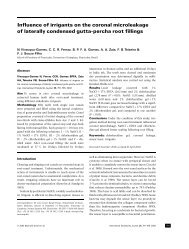Sodium hypochlorite in endodontics
Sodium hypochlorite in endodontics
Sodium hypochlorite in endodontics
Create successful ePaper yourself
Turn your PDF publications into a flip-book with our unique Google optimized e-Paper software.
338<br />
experienced acute severe facial pa<strong>in</strong> and swell<strong>in</strong>g. Occipito-mental<br />
radiographs demonstrated an air fluid level<br />
<strong>in</strong> the right maxillary s<strong>in</strong>us. The antrum was dra<strong>in</strong>ed<br />
surgically under general anaesthesia. Three weeks<br />
later most of the symptoms had resolved and only the<br />
premolar presented with localised discomfort; this led<br />
to the decision to extract the tooth. Further heal<strong>in</strong>g was<br />
uneventful and complete.<br />
Allergic reactions to NaOCl<br />
Hypersensitivity reactions to sodium <strong>hypochlorite</strong> have<br />
also been reported. Kaufman and Keila125 reported a<br />
case which was detected before <strong>in</strong>itiation of endodontic<br />
therapy so that the patient was referred to an allergist.<br />
Follow<strong>in</strong>g a sk<strong>in</strong> patch test, the allergist diagnosed a hypersensitivity<br />
to household materials conta<strong>in</strong><strong>in</strong>g NaOCl<br />
and recommended not us<strong>in</strong>g NaOCl dur<strong>in</strong>g root canal<br />
treatment. The canals were irrigated with Solvidont and<br />
the procedure was uneventful. In a second case, sodium<br />
<strong>hypochlorite</strong> (1%) was used for irrigation of a maxillary<br />
central <strong>in</strong>cisor with midroot horizontal fracture. The<br />
patient immediately reported severe pa<strong>in</strong> and a burn<strong>in</strong>g<br />
sensation, with<strong>in</strong> a few seconds the upper lip and cheek<br />
up to the <strong>in</strong>fraorbital area became swollen, accompanied<br />
by ecchymosis and profuse haemorrhage from the root<br />
canal. Pa<strong>in</strong> dim<strong>in</strong>ished after a few m<strong>in</strong>utes but the patient<br />
compla<strong>in</strong>ed about problems <strong>in</strong> breath<strong>in</strong>g and was<br />
referred to an emergency care unit. Systemic corticosteroid<br />
and antihistam<strong>in</strong>e were adm<strong>in</strong>istered <strong>in</strong>travenously<br />
and antibiotics were prescribed. Swell<strong>in</strong>g resolved after<br />
three days, but a paraesthesia on the left side of the face<br />
rema<strong>in</strong>ed for 10 days. Further endodontic therapy was<br />
performed with hydrogen peroxide and sterile sal<strong>in</strong>e<br />
and was uneventful. A sk<strong>in</strong> scratch test was performed<br />
some days after the <strong>in</strong>cident and gave a very rapid positive<br />
allergic reaction126 .<br />
Conclusions<br />
• <strong>Sodium</strong> <strong>hypochlorite</strong> has a wide range activity aga<strong>in</strong>st<br />
both Gram positive and Gram negative bacteria<br />
• <strong>Sodium</strong> <strong>hypochlorite</strong> is the strongest antifungal agent<br />
among root canal irrigations and medications<br />
• <strong>Sodium</strong> <strong>hypochlorite</strong> is the only root canal irrigant<br />
that can destroy the microbial biofilm effectively<br />
• Utilis<strong>in</strong>g sodium <strong>hypochlorite</strong> for decontam<strong>in</strong>ation<br />
of the microbial sampl<strong>in</strong>g field is controversial<br />
• It seems that dent<strong>in</strong>e reduces or <strong>in</strong>hibits the antibacterial<br />
activity of sodium <strong>hypochlorite</strong><br />
• <strong>Sodium</strong> <strong>hypochlorite</strong> is a non-specific proteolytic<br />
agent with an excellent tissue dissolv<strong>in</strong>g ability<br />
• Effects of sodium <strong>hypochlorite</strong> on the mechanical<br />
properties and the cutt<strong>in</strong>g efficiency of Nickel-Titanium<br />
<strong>in</strong>struments are still controversial<br />
International Dental Journal (2008) Vol. 58/No.6<br />
• It seems that heat<strong>in</strong>g sodium <strong>hypochlorite</strong> <strong>in</strong>creases<br />
its antimicrobial and tissue dissolv<strong>in</strong>g abilities<br />
• <strong>Sodium</strong> <strong>hypochlorite</strong> exerts deteriorative effects on<br />
mechanical properties and chemical composition of<br />
dent<strong>in</strong>e<br />
• Effects of sodium <strong>hypochlorite</strong> on the bond strength<br />
of bond<strong>in</strong>g systems are still controversial<br />
• Excellent haemostatic activity of sodium <strong>hypochlorite</strong><br />
may enhance the prognosis of vital pulp therapy<br />
• Cytotoxicity and tissue toxicity of sodium <strong>hypochlorite</strong><br />
is well documented<br />
• Most complications of the use of sodium <strong>hypochlorite</strong><br />
appear to be the result of its <strong>in</strong>advertent <strong>in</strong>jection<br />
beyond the root apex which can cause violent tissue<br />
reactions (<strong>hypochlorite</strong> accident)<br />
• In rare cases sodium <strong>hypochlorite</strong> may cause allergic<br />
reactions.<br />
References<br />
1. Kakehashi S, Stanley HR, Fitzgerald RJ. The effects of surgical<br />
exposure of dental pulps <strong>in</strong> germ-free and conventional laboratory<br />
rats. Oral Surg Oral Med Oral Pathol 1965 18: 340-348.<br />
2. Moller AJ, Fabricius L, Dahlen G et al. Influence on periapical<br />
tissues of <strong>in</strong>digenous oral bacteria and necrotic pulp tissue <strong>in</strong><br />
monkeys. Scand J Dent Res 1981 89: 475-484.<br />
3. Sundqvist G. Ecology of the root canal flora. J Endod 1992 18:<br />
427-430.<br />
4. Bystrom A, Sundqvist G. Bacteriologic evaluation of the efficacy<br />
of mechanical root canal <strong>in</strong>strumentation <strong>in</strong> endodontic therapy.<br />
Scand J Dent Res 1981 89: 321-328.<br />
5. Hess, W. Anatomy of root canals of the teeth of the permanent<br />
dentition. Sons and Danielson Ltd, 1925.<br />
6. Peters OA, Laib A, Gohr<strong>in</strong>g TN et al. Changes <strong>in</strong> root canal<br />
geometry after preparation assessed by high resolution computed<br />
tomography. J Endod 2001 27: 1-6.<br />
7. Zehnder M. Root canal irrigants. J Endod 2006 32: 389-398.<br />
8. Test ST, Lampert MB, Ossanna PJ et al. Generation of nitrogen-chlor<strong>in</strong>e<br />
oxidants by human phagocytes. J Cl<strong>in</strong> Investig 1984<br />
74:1341-1349.<br />
9. Dak<strong>in</strong> HD. On the use of certa<strong>in</strong> antiseptic substances <strong>in</strong> treatment<br />
of <strong>in</strong>fected wounds. BMJ 1915 2: 318-320.<br />
10. McDonnell G, Russell AD. Antiseptics and dis<strong>in</strong>fectants: activity,<br />
action and resistance. Cl<strong>in</strong> Microbiol Rev 1999 12: 147-179.<br />
11. Aust<strong>in</strong> JH, Taylor HD. Behavior of <strong>hypochlorite</strong> and chloram<strong>in</strong>es-<br />
T solutions <strong>in</strong> contact with necrotic and normal tissue In vivo. J<br />
Exp Med 1918 27: 627-633.<br />
12. Coolidge ED. The diagnosis and treatment of conditions result<strong>in</strong>g<br />
from diseased dental pulps. J Nat Dent Assoc 1919 6: 337-349.<br />
13. Frais S, Ng YL, Gulabivala K. Some factors affect<strong>in</strong>g the concentration<br />
of available chlor<strong>in</strong>e <strong>in</strong> commercial sources of sodium<br />
<strong>hypochlorite</strong>. Int Endod J 2001 34: 206-215.<br />
14. Lambjerg-Hansen H, Fiehn NE, Krogh P. Endodontiske medikamenter.<br />
Tandlaegebladet 1982 86: 467-473.<br />
15. Hel<strong>in</strong>g I, Rotste<strong>in</strong> I, D<strong>in</strong>ur T et al. Bactericidal and cytotoxic effects<br />
of sodium <strong>hypochlorite</strong> and dichloroisocyanurate solutions<br />
<strong>in</strong> vitro. J Endod 2001 27: 278-280.<br />
16. Estrela C, Estrela CR, Barb<strong>in</strong> EL et al. Mechanism of action of<br />
sodium <strong>hypochlorite</strong>. Braz Dent J 2002 13: 113-117.





